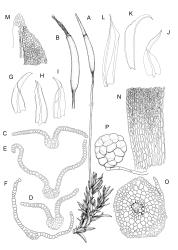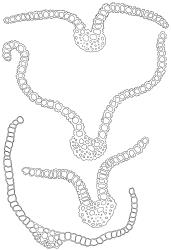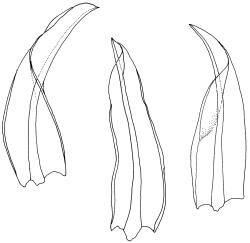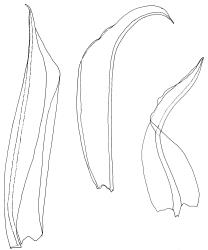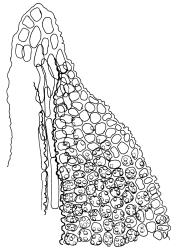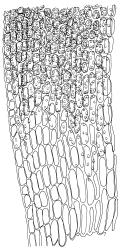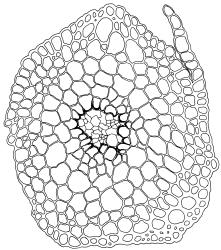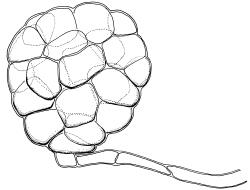- ≡ Barbula convoluta Hedw., Sp. Musc. Frond. 120 (1801)
Plants bright yellow-green above, brown below, forming tufts or turves, usually on soil. Stems 3–10 mm, in cross-section with a central strand, a weakly developed sclerodermis, and with the outermost walls of the surface cells thin. Leaves erect-spreading to spreading when moist, incurved, or individually twisted, and often weakly twisted around the stem when dry, 1.0–1.7 mm, oblong-lanceolate, carinate, acute, often with a conspicuous unicellular, hyaline apiculus (not illustrated); margins variably recurved in basal half, plane and often undulate above, crenulate-papillose; upper laminal cells obscure, quadrate to round-rhombic, some oblate, firm-walled, evenly thickened, pluripapillose with complex papillae, (6.0–) 9–10.5 × 7.5–9.0 µm; upper marginal cells mostly shorter in one row; lower laminal cells gradually transitioning from upper laminal cells, extending higher medially, rectangular, thick-walled, with scattered simple papillae, smooth in the extreme base, and one row shorter at the margin, forming a weak border. Costa failing 1–3 cells below the leaf apex or percurrent, sunken in a deep groove adaxially; adaxial superficial cells long-rectangular, ± smooth; abaxial superficial cells elongate and papillose in distal ⅔ of leaf. Rhizoidal tubers often present, sub-spherical to ellipsoid-pyriform, (70–)100–120(–150) µm long, brown with internal walls thin and dark red, non-protuberant surface cells. Laminal KOH colour reaction yellow.
Perichaetia with leaves conspicuously sheathing the seta base and the inner leaves strongly differentiated, appressed, acuminate or rounded at apex from a long, tightly convolute base, with upper laminal cells vermicular and smooth. Perigonia not seen in N.Z. material. Setae slender, yellow, 10–16 mm. Capsules erect, asymmetric, subcylindric, tapering from near base to mouth, brown, becoming red at the mouth, with a well-developed annulus, 2.0–2.6 mm. Operculum long-conic, ⅓ –½ the theca length with cells spirally arranged. Peristome c. 1.0 mm, light brown, of 32 spiralled rami, densely spiculose, very weakly articulate, twisted several times to the right from a low basal cylinder. Spores 8–10 µm, smooth.
Crum & Anderson 1981, fig. 152, a–h (as Barbula convoluta); Smith 2004, fig. 95, 1–7 (as Barbula convoluta); Porley 2008, pp. 70–71 (as Barbula convoluta); Lüth 2019, p. 586; Malcolm et al. 2020, p. 492 (as Barbula convoluta).
When fruiting, S. convolutum is distinctive in its sheathing perichaetial bracts and yellow setae. Confusion of sterile material may occur with species of Bryoerythrophyllum, the leaves of which have a similar areolation, including a hyaline apical cell. The lack of any red coloration and of any teeth on the leaf margin near the leaf apex in S. convolutum will help to distinguish it from both N.Z. species of Bryoerythrophyllum. As a definitive test, S. convolutum laminal cell walls are "KOH yellow" whereas those of Bryoerythrophyllum spp. are "KOH red".
NI: N Auckland, including offshore islands (RT), Wellington; SI: Canterbury, Otago; Ch.
Adventive. Recorded from mainland Australia (as Barbula convoluta) by Streimann & Klazenga (2002). Widespread in the northern hemisphere (as Barbula convoluta) according to Smith (2004).
This species is found in exposed sites, mainly in urban settings, on soil, brickwork, concrete, basalt stonework, and on trapped sand in cracks of footpaths. The earliest known N.Z. record is from Cheltenham Beach, Auckland City, on a rock wall (R.G. Robbins 169, WELT M011246). It has also been recorded on natural substrates, such as basalt outcrops in Auckland City, and on a fossiliferous limestone cliff on the western flank of the Ruahine Range (R.E. Beever s.n., AK 386921). Associated mosses include Barbula unguiculata, Bryum argenteum, Ceratodon purpureus, and Tortula muralis.
Most records are from <50 m a.s.l., and near ports, perhaps reflecting sites of introduction. The Ruahine Range site mentioned above, however, is at 620 m a.s.l. and relatively remote.
Molecular data, from rps4 and trnM-trnV loci in addition to ITS sequences, for two European specimens of B. convoluta (Kučera et al. 2013), supported inclusion of the species in the resurrected genus Streblotrichum, and their placement is accepted here.




